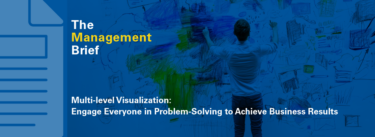Yes of course, much more. Don’t get me wrong; I’m a big proponent of running many kaizen events. I believe this is the fastest way to make dramatic improvements to your value adding processes while teaching all of your people how to see and remove the waste that they just took for granted before. Without an aggressive kaizen approach you won’t get very far in your lean turnaround. But don’t get confused, a bunch of kaizen events are not the end point.
As your lean turnaround moves along, what you are really aiming for is a state of continuous improvement that leverages the collective knowledge of all your people. This goes beyond isolated kaizen events where learning is expected to happen; it means that every person in the company is eliminating waste and making improvements every day. Kaizen events are great for making the very difficult transition from batch to flow. But kaizen events need to be built upon.
Employee suggestion programs are a great example: they build on the progress made by the initial kaizen events with many small, easy-to-implement ideas for improvement. Each of these improvements can be considered a kaizen. The key with this type of approach is to make sure it is managed at the local level with the immediate supervisors approving and implementing the ideas.
Another form of simple, easy, daily kaizen is the countermeasures that should flow out of your daily management meetings at the point of value-adding. These are corrective actions to a problem that may have popped up today that you don’t want to see reoccur. They could also be responses to longer-term problems that you want to end.
Another way that lean continues far beyond kaizen events is the traditional quality circle approach at the local level to problem-solving. This is a great way to remove waste on an ongoing basis once some initial kaizen events have established a new cell, for example. At Wiremold’s China plant we had many assembly cells with from ten to thirteen operators. Each one had its own supervisor. We required each of these supervisors to come up with one improvement idea each week that could be implemented. They used their teams to help generate the ideas. We made sure that ideas implemented in one cell that applied to other cells were implemented everywhere. The ongoing kaizen leverage off of this simple program was tremendous.
So while there are dramatic improvements that can happen when you start lean don’t expect miracles at first. Many of the teams will struggle. Your job as a management team is to help, not criticize them. Keep the entire organization constantly focused on your vision of where you are trying to take your company, which should be about achieving your operational excellence goals (you have created stretch operational excellence goals, right?).
Bit by bit you will get better. Driving for a set of stretch future goals will become the norm. Celebrate your wins. Publicize the gains. Create a monthly kaizen newsletter or some other way to recognize and reward the good work. Your people will be learning so much so quickly that even the constant pressure on these operational excellence goals will begin to feel like a fun challenge rather that a burden. The important thing is that you will always be ‘managing forward’ by focusing on your processes not your results.
Just think of how big these ‘small’ changes can be. First of all, creating a value stream organization sends a strong message to everyone in the company that things will be different. Then you couple this message with new behavior: managing the company by having these value streams focus on your operational excellence targets. Then everyone can understand and align with your core strategy. Next you make it clear through weekly value stream review meetings that you are not only serious about hitting these targets, but that you understand that the CEO and senior management team’s role is to do every thing you can to support the value stream teams. Couple this with an aggressive kaizen program with strong KPO support that teaches your people how remove the waste and make significant progress towards the goals in a rapid fire way. Before long you will realize that you have a completely different company.
That’s why kaizen events are great but they are not the ultimate objective. You want to get to the point where everybody is doing kaizen everyday. You need an environment where everyone can distinguish normal from abnormal and take immediate action to correct and permanently eliminate the problems as they are revealed. In fact, it’s even more sophisticated than that: what Toyota’s line stop approach is really pushing is learning.
Every time the line stops, the supervisor rushes to the spot of the problem. There is a conversation with the operator to determine what went wrong. A solution is implemented and the line starts back up. The operator and the supervisor both learned something and if the problem were big enough the engineers get involved. They are constantly coming up with solutions. Everyone, especially the operators, is asked to use the 5Whys to get at the root cause of the stoppages. Instead of ‘correcting’ the defect after it occurs, they discover what made it happen and make the adjustment so that it never recurs. By doing this they are permanently solving a lot of problems every day. The line might stop over 100 times a day. Each time problems are being solved and eliminated and everyone involved is learning. The line starts to run much smoother. It requires less people. Quality improves and productivity goes up. Everyone is becoming a problem solver. Operators are asked to come up with ideas that will improve quality and make their jobs easier. Waste is being eliminated through learning.
Kaizen events are the catalyst, but continuous improvement and continuous learning by everyone in the company are the real objectives.





